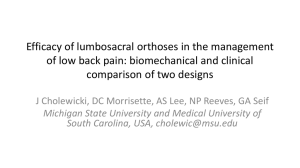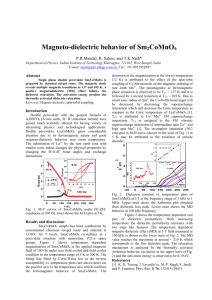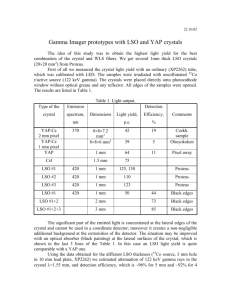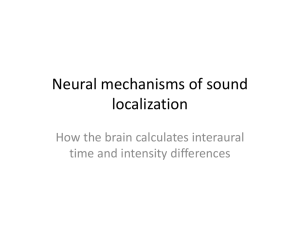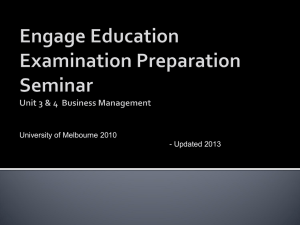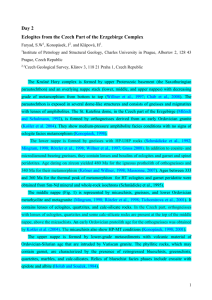View
advertisement
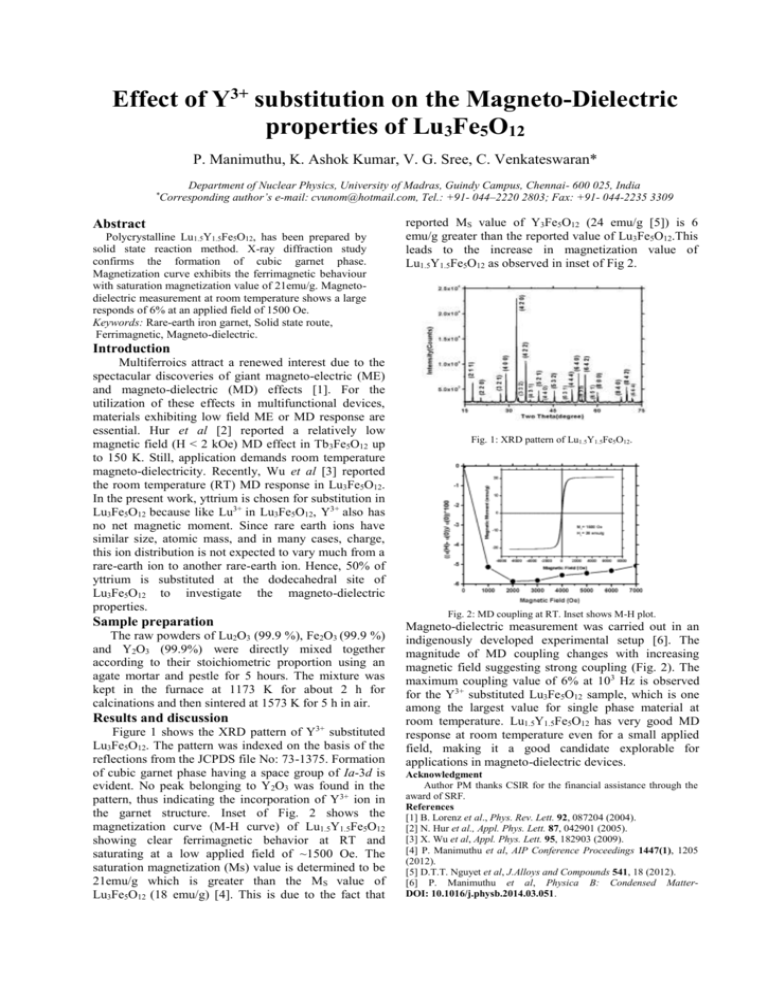
Effect of Y3+ substitution on the Magneto-Dielectric properties of Lu3Fe5O12 P. Manimuthu, K. Ashok Kumar, V. G. Sree, C. Venkateswaran* Department of Nuclear Physics, University of Madras, Guindy Campus, Chennai- 600 025, India author’s e-mail: cvunom@hotmail.com, Tel.: +91- 044–2220 2803; Fax: +91- 044-2235 3309 *Corresponding Abstract Polycrystalline Lu1.5Y1.5Fe5O12, has been prepared by solid state reaction method. X-ray diffraction study confirms the formation of cubic garnet phase. Magnetization curve exhibits the ferrimagnetic behaviour with saturation magnetization value of 21emu/g. Magnetodielectric measurement at room temperature shows a large responds of 6% at an applied field of 1500 Oe. Keywords: Rare-earth iron garnet, Solid state route, Ferrimagnetic, Magneto-dielectric. reported MS value of Y3Fe5O12 (24 emu/g [5]) is 6 emu/g greater than the reported value of Lu3Fe5O12.This leads to the increase in magnetization value of Lu1.5Y1.5Fe5O12 as observed in inset of Fig 2. Introduction Multiferroics attract a renewed interest due to the spectacular discoveries of giant magneto-electric (ME) and magneto-dielectric (MD) effects [1]. For the utilization of these effects in multifunctional devices, materials exhibiting low field ME or MD response are essential. Hur et al [2] reported a relatively low magnetic field (H < 2 kOe) MD effect in Tb 3Fe5O12 up to 150 K. Still, application demands room temperature magneto-dielectricity. Recently, Wu et al [3] reported the room temperature (RT) MD response in Lu3Fe5O12. In the present work, yttrium is chosen for substitution in Lu3Fe5O12 because like Lu3+ in Lu3Fe5O12, Y3+ also has no net magnetic moment. Since rare earth ions have similar size, atomic mass, and in many cases, charge, this ion distribution is not expected to vary much from a rare-earth ion to another rare-earth ion. Hence, 50% of yttrium is substituted at the dodecahedral site of Lu3Fe5O12 to investigate the magneto-dielectric properties. Sample preparation The raw powders of Lu2O3 (99.9 %), Fe2O3 (99.9 %) and Y2O3 (99.9%) were directly mixed together according to their stoichiometric proportion using an agate mortar and pestle for 5 hours. The mixture was kept in the furnace at 1173 K for about 2 h for calcinations and then sintered at 1573 K for 5 h in air. Results and discussion Figure 1 shows the XRD pattern of Y3+ substituted Lu3Fe5O12. The pattern was indexed on the basis of the reflections from the JCPDS file No: 73-1375. Formation of cubic garnet phase having a space group of Ia-3d is evident. No peak belonging to Y2O3 was found in the pattern, thus indicating the incorporation of Y3+ ion in the garnet structure. Inset of Fig. 2 shows the magnetization curve (M-H curve) of Lu1.5Y1.5Fe5O12 showing clear ferrimagnetic behavior at RT and saturating at a low applied field of ~1500 Oe. The saturation magnetization (Ms) value is determined to be 21emu/g which is greater than the MS value of Lu3Fe5O12 (18 emu/g) [4]. This is due to the fact that Fig. 1: XRD pattern of Lu1.5Y1.5Fe5O12. Fig. 2: MD coupling at RT. Inset shows M-H plot. Magneto-dielectric measurement was carried out in an indigenously developed experimental setup [6]. The magnitude of MD coupling changes with increasing magnetic field suggesting strong coupling (Fig. 2). The maximum coupling value of 6% at 103 Hz is observed for the Y3+ substituted Lu3Fe5O12 sample, which is one among the largest value for single phase material at room temperature. Lu1.5Y1.5Fe5O12 has very good MD response at room temperature even for a small applied field, making it a good candidate explorable for applications in magneto-dielectric devices. Acknowledgment Author PM thanks CSIR for the financial assistance through the award of SRF. References [1] B. Lorenz et al., Phys. Rev. Lett. 92, 087204 (2004). [2] N. Hur et al., Appl. Phys. Lett. 87, 042901 (2005). [3] X. Wu et al, Appl. Phys. Lett. 95, 182903 (2009). [4] P. Manimuthu et al, AIP Conference Proceedings 1447(1), 1205 (2012). [5] D.T.T. Nguyet et al, J.Alloys and Compounds 541, 18 (2012). [6] P. Manimuthu et al, Physica B: Condensed MatterDOI: 10.1016/j.physb.2014.03.051.
![Photoinduced Magnetization in RbCo[Fe(CN)6]](http://s3.studylib.net/store/data/005886955_1-3379688f2eabadadc881fdb997e719b1-300x300.png)



